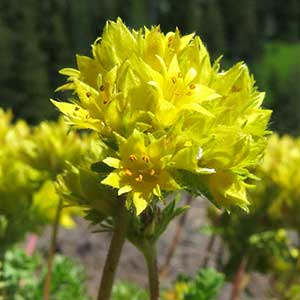Ivesia gordonii
Ivesia pityocharis
alpine ivesia, alpine mousetail, Gordon's ivesia
pine nut mountain mousetail, pine nut mountains ivesia
prostrate to erect, (0.2–)0.5–4 dm.
prostrate-decumbent to ascending, 0.5–2(–3) dm.
tightly to loosely cylindric, (1–)3–20(–25) cm; sheathing base ± glandular abaxially, otherwise glabrous;
petiole 0.5–8 cm, hairs 0.2–0.5 mm;
leaflets (6–)10–25 per side, (1–)2–13(–18) mm, glabrous or ± hirsute or villous, glandular-puberulent or -pubescent, lobes (2–)4–8(–15), linear or narrowly oblanceolate to obovate, apex rarely setose.
6–12(–15) cm; sheathing base weakly strigose abaxially;
stipules absent;
petiole (1–)1.5–2.5(–3) cm, hairs abundant, ascending to spreading, 1–4 mm;
leaflets 15–25 per side, loosely overlapping, (1.5–)2–7 mm, lobes 0–4(–6), lanceolate or oblanceolate to elliptic, hairs abundant, spreading to ascending, 1–3 mm.
1(–2), not paired.
2–5.
5–50(–70)-flowered, 1–8(–11) cm diam.;
glomerules 1–several.
(7–)15–50-flowered, 2–8 cm diam., flowers arranged individually and/or in several to many loose few-flowered glomerules.
1–3(–5) mm.
(3–)6–15(–22) mm.
5–12 mm diam.;
epicalyx bractlets linear to narrowly elliptic, (0.5–)1–3.5(–4) mm;
hypanthium turbinate to campanulate, (1.5–)2–4(–4.5) × 2–4(–5) mm;
sepals (2–)2.5–5(–6) mm, obtuse to ± acute;
petals yellow, narrowly oblanceolate to narrowly spatulate, (1–)1.5–3 mm;
stamens 5, filaments 1.3–2.5 mm, anthers yellow, sometimes red-margined, 0.5–1 mm;
carpels (1–)2–4(–6), styles 2.5–4.5(–6) mm.
8–13 mm diam.;
epicalyx bractlets lanceolate to elliptic, 2–3 mm;
hypanthium patelliform to shallowly cupulate, 1.5–2.5 × 3–4.5 mm, ± 1/2 as deep as wide;
sepals often purple-suffused, 2.3–4(–5) mm, acute;
petals white, broadly spatulate or obovate to orbiculate, (2.8–)3–5(–6) mm;
stamens 20, filaments filiform, (1–)1.5–3 mm, anthers light pink, 0.3–0.5 mm;
carpels 8–20, styles 2.2–3 mm.
grayish brown to mottled brown, ± 2 mm.
light brown, 1.2–1.3 mm.
Ivesia gordonii
Ivesia pityocharis
Varieties 4 (4 in the flora).
Ivesia gordonii is the most widespread species of the genus, occurring from Washington to Montana, south to central California and Colorado. The species can be distinguished from other members of sect. Ivesia by the relatively deep hypanthium, which is about as deep as wide. Four varieties are provisionally recognized here (B. Ertter and J. L. Reveal 2007), with the likelihood that future work may indicate additional and/or alternate circumscriptions. Populations that are difficult to assign to a variety can be found where the recognizable taxonomic units come together, for example, in northeastern Utah and western Wyoming, involving var. gordonii and var. wasatchensis, and in California and central Idaho where var. alpicola and var. ursinorum tend to merge.
(Discussion copyrighted by Flora of North America; reprinted with permission.)
Of conservation concern.
Ivesia pityocharis is known only from the Pine Nut Mountains, Douglas County. Plants are somewhat intermediate between those of I. kingii and I. sericoleuca in having relatively shallow hypanthia and loosely sericeous vestiture. Hairs on petioles and stem bases of I. pityocharis are to 4 mm; those of I. kingii are 1 mm and generally appressed-ascending.
(Discussion copyrighted by Flora of North America; reprinted with permission.)
1. Leaflets 7–13(–18) mm, glabrous or sparsely hirsute or villous marginally; stems (1–)1.5–4 dm; inflorescences usually branched, 2–8(–11) cm diam., glomerules (1–)2–6(–10), ± capitate. | var. wasatchensis |
1. Leaflets (1–)2–7(–9) mm, hairy or ± glabrous except marginally ciliate; stems (0.2–)0.5–2.5 dm; inflorescences simple or branched, 1–3(–5) cm diam., glomerules 1(–3), ± capitate to loosely congested | → 2 |
2. Stems usually prostrate to ascending, rarely nearly erect, usually dark reddish, minutely glandular or glandular-puberulent to -pubescent; leaves to 0.8 cm diam.; anthers usually red-margined. | var. ursinorum |
2. Stems usually ascending to erect, sometimes decumbent, usually greenish, rarely reddish, hirsute to villous, glandular-puberulent to -pubescent; leaves to 1.5 cm diam.; anthers rarely red-margined | → 3 |
3. Stems usually hirsute to villous, sometimes densely so, glandular-pubescent or eglandular; basal leaves (3–)5–10(–15) cm; flowers 7–12 mm diam.; e Idaho and w Montana to Utah, Wyoming, and w Colorado. | var. gordonii |
3. Stems not or sparsely hirsute to villous, glandular-puberulent or -pubescent; basal leaves 2–8(–10) cm; flowers 5–9 mm diam.; s Washington to California and e to w Montana. | var. alpicola |


